LEGAL


Written by a transactional intellectual property attorney, The Law of Fraudulent Transfers Applied to Patent Assignments, Licenses, and Security Interests explores the three bodies of law under which fraudulent transfer claims can arise: (1) federal bankruptcy law, (2) pure state law not involving bankruptcy, and (3) a mixture of federal bankruptcy law and state law.
Fraudulent transfer law is not the law of fraud. On their face, fraudulent transfer laws are easy to misconstrue without additional guidance. This book aims to provide guidance in the face of confusion propagated through caselaw and to examine how third parties to a transaction involving patent assignments, licenses, or security interests have used fraudulent transfer law to at least extract money from transferees and, at times, gain ownership of the transferred patent itself.
Patents can be particularly vulnerable to fraudulent transfer claims. It can be difficult to ascribe value to a patent with any degree of certainty. Yet, lack of exchange of reasonably equivalent value for a patent can open the door to a claim of fraudulent transfer in many cases. This book provides a detailed discussion of patent valuation in view of how valuation can be used in advance of or to defend against fraudulent transfer claims involving patents.
Enter replacement volume, chapter and page numbers separated by commas. For example: Volume 2, Chapter 5, Pages 7, 12-19. Please limit requests to 25 pages or less. If you are located outside the United States or for more than 25 pages please contact Customer Service 1-800-328-4880.